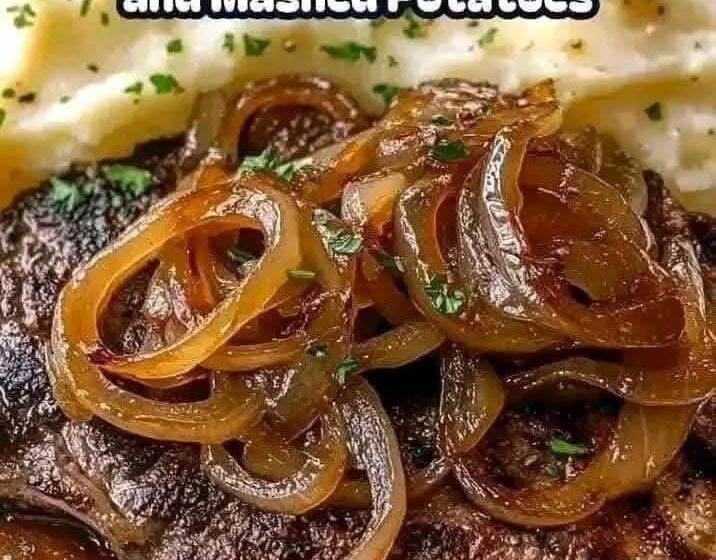Caramelized Ribeye Steak
Of course! Achieving a perfectly caramelized, crusty ribeye steak with a tender, juicy interior is a hallmark of great cooking. This method focuses on technique to maximize flavor through the Maillard reaction.
Here is a detailed, recipe-formatted guide.
Caramelized Ribeye Steak
This recipe uses a simple yet precise technique to create a deep, flavorful crust on a ribeye steak, whether you’re cooking it in a cast-iron skillet or on the grill.
- Yield: 1-2 servings
- Prep Time: 5 minutes (plus resting time)
- Cook Time: 10-15 minutes
Ingredients
· 1 (1 to 1.5-inch thick) bone-in or boneless ribeye steak (approx. 1-1.5 lbs)
· Kosher salt and freshly ground black pepper
· 1-2 tablespoons high-smoke-point oil (avocado, grapeseed, or canola)
· 2-3 tablespoons unsalted butter
· 2-3 cloves garlic, lightly smashed
· 2-3 fresh thyme or rosemary sprigs
Instructions
- Prepare the Steak (The Most Important Step):
· Dry the Surface: At least 1 hour (and up to 24 hours) before cooking, pat the steak extremely dry with paper towels. Place it on a wire rack set over a baking sheet, uncovered, in the refrigerator. This air-dries the surface, which is the absolute key to achieving a deep, caramelized crust, not a steamy gray sear.
· Season Generously: Right before cooking, take the steak out of the fridge. Season both sides liberally with kosher salt and a heavy crack of black pepper. Press the seasoning into the meat.
- Preheat the Pan:
· Place a heavy-bottomed skillet (cast iron is ideal) over medium-high to high heat. Let it get screaming hot for a good 3-5 minutes. You should see wisps of smoke.
· Add the high-smoke-point oil and swirl to coat the pan.
- Sear the First Side:
· Carefully place the steak in the center of the hot pan. It should sizzle loudly.
· DO NOT TOUCH IT. Let it cook, undisturbed, for 2-4 minutes (depending on thickness), until a deep brown, caramelized crust has formed. You can gently lift a corner to check.
- Flip and Sear the Second Side:
· Use tongs to flip the steak. Sear the second side for another 2-4 minutes, again without moving it, to build the crust.
- Add Aromatics and Baste (Optional but Recommended):
· Reduce the heat to medium. Add the butter, smashed garlic cloves, and herb sprigs to the pan.
· As the butter melts, tilt the pan slightly and use a spoon to continuously baste the top of the steak with the foaming butter and aromatics for 1-2 minutes. This flavors the steak and helps cook the sides.
- Check for Doneness:
· For a perfect medium-rare, the internal temperature should be 125-130°F (52-54°C). The best way to check is with an instant-read thermometer inserted horizontally into the side of the steak.
· Touch Test (approx.):
· Rare: Soft with little resistance (120°F)
· Medium-Rare: Soft but slightly springy (130°F)
· Medium: Firmly springy (140°F)
- Rest the Steak:
· Transfer the steak to a wire rack (not a plate, to prevent steaming) and let it rest for at least 5-10 minutes. This allows the juices to redistribute throughout the meat. If you cut it too early, the juices will run out.
- Serve:
· Slice the steak against the grain to ensure tenderness. Serve immediately, spooning a little of the infused butter from the pan over the top.
Chef’s Notes & Tips for Success:
· The Dry Brine: Salting the steak hours ahead and leaving it uncovered in the fridge is a game-changer. It seasons the meat deeply and dries the surface for unparalleled browning.
· Thickness Matters: For the best crust and juicy interior, a steak that is at least 1-inch thick is essential. Thin steaks will overcook before a good crust forms.
· Don’t Crowd the Pan: Cook one steak at a time. Overcrowding the pan lowers the temperature and causes the steak to steam instead of sear.
· The Thermostat is Your Friend: For perfect results every time, use an instant-read thermometer. It takes the guesswork out of cooking.
· Grill Method: The principles are the same. Get your grill screaming hot. Sear the steak over direct heat with the lid open to build the crust. If the steak is thick, move it to indirect heat to finish cooking to your desired doneness.
· Resting is Non-Negotiable: Resting the steak is what ensures a juicy, tender result. The internal temperature will also rise by 5-10 degrees during this time (carryover cooking).
Enjoy your perfectly caramelized, restaurant-quality ribeye steak!


